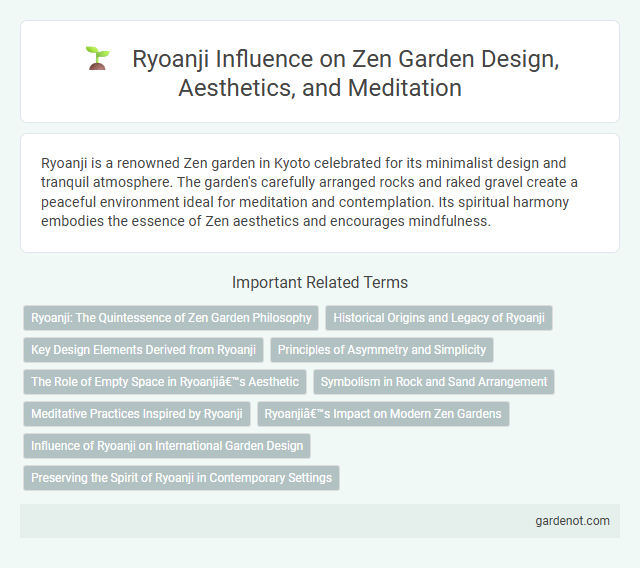Ryoanji is a renowned Zen garden in Kyoto celebrated for its minimalist design and tranquil atmosphere. The garden's carefully arranged rocks and raked gravel create a peaceful environment ideal for meditation and contemplation. Its spiritual harmony embodies the essence of Zen aesthetics and encourages mindfulness.
Ryoanji: The Quintessence of Zen Garden Philosophy
Ryoanji Temple in Kyoto exemplifies the quintessence of Zen garden philosophy through its minimalist design and strategically placed fifteen stones, which invite endless contemplation and introspection. The garden's raked gravel symbolizes water, enhancing the meditative experience central to Zen practices. This carefully balanced arrangement embodies the principles of simplicity, harmony, and tranquility fundamental to Zen aesthetics.
Historical Origins and Legacy of Ryoanji
Ryoanji, established in the late 15th century during Japan's Muromachi period, exemplifies the Zen garden tradition with its meticulously arranged rocks and raked gravel symbolizing natural elements. The garden's design reflects Zen Buddhist principles of simplicity, meditation, and enlightenment, influencing subsequent Japanese garden aesthetics and global interpretations of minimalism. Its legacy endures as a cultural treasure, attracting scholars and tourists seeking spiritual reflection and artistic inspiration.
Key Design Elements Derived from Ryoanji
The iconic Ryoanji Zen garden features fifteen carefully arranged rocks symbolizing islands or animals, set within a bed of white gravel meticulously raked into patterns representing water ripples. The minimalist design emphasizes asymmetry and negative space to evoke tranquility and contemplation, allowing viewers to interpret meaning uniquely. Surrounding moss and a simple wooden veranda enhance the natural harmony and meditative atmosphere central to Zen aesthetics.
Principles of Asymmetry and Simplicity
Ryoanji Zen garden exemplifies the principles of asymmetry and simplicity through its carefully arranged fifteen stones set on a bed of white gravel, creating an intentionally unbalanced yet harmonious composition. The asymmetrical placement encourages contemplation by avoiding uniform patterns, while simplicity is maintained by minimal elements that evoke tranquility and focus. This design reflects Zen aesthetics, emphasizing naturalness, subtlety, and the beauty found in imperfection.
The Role of Empty Space in Ryoanji’s Aesthetic
Ryoanji's Zen garden masterfully employs empty space to embody the principles of simplicity and tranquility, using carefully arranged rocks and raked gravel to evoke profound contemplation. The absence of vegetation and open, unadorned areas create a sense of infinite openness, allowing viewers to experience stillness and mental clarity. This strategic use of emptiness emphasizes the beauty of minimalism, aligning with Zen Buddhist ideals of mindfulness and impermanence.
Symbolism in Rock and Sand Arrangement
Ryoanji's rock and sand arrangement symbolizes the harmony between simplicity and complexity, representing the universe in miniature form. The fifteen stones, deliberately placed in five groups, embody the Buddhist concept of enlightenment and the balance between emptiness and form. The surrounding raked sand mimics water, enhancing a meditative experience by inviting viewers to contemplate impermanence and tranquility.
Meditative Practices Inspired by Ryoanji
Ryoanji's Zen garden embodies meditative practices centered on simplicity and mindfulness, using carefully arranged rocks and raked gravel to foster deep contemplation and inner peace. The garden's minimalist design encourages visitors to engage in focused observation, promoting a state of calm awareness and reflection. This practice aligns with Zen principles by helping individuals detach from distractions and connect with the present moment through spatial harmony and natural elements.
Ryoanji’s Impact on Modern Zen Gardens
Ryoanji in Kyoto serves as a quintessential model influencing the minimalist aesthetics and contemplative space design of modern Zen gardens worldwide. Its carefully arranged fifteen-stone composition on a bed of white gravel fosters meditation through simplicity and asymmetry, principles that define contemporary Zen landscaping. The garden's profound harmony between natural elements and symbolic meaning continues to inspire garden architects aiming to evoke tranquility and mindfulness.
Influence of Ryoanji on International Garden Design
Ryoanji's minimalist rock garden has profoundly shaped international garden design by inspiring a global appreciation for simplicity, balance, and the concept of ma (negative space). Its use of natural elements arranged in asymmetrical harmony influences contemporary landscape architecture and Zen-inspired gardens worldwide. Designers incorporate Ryoanji's principles to evoke tranquility, contemplation, and an intimate connection with nature.
Preserving the Spirit of Ryoanji in Contemporary Settings
The spirit of Ryoanji Zen garden is preserved in contemporary settings by maintaining its minimalist design principles and symbolic rock arrangements, which embody simplicity and tranquility. Modern interpretations emphasize natural materials, asymmetry, and the balance of empty space to evoke meditative reflection. Efforts to sustain Ryoanji's cultural heritage include integrating traditional Japanese landscaping techniques with urban aesthetics, ensuring the garden's timeless essence endures amidst evolving environments.
Ryoanji Infographic

 gardenot.com
gardenot.com